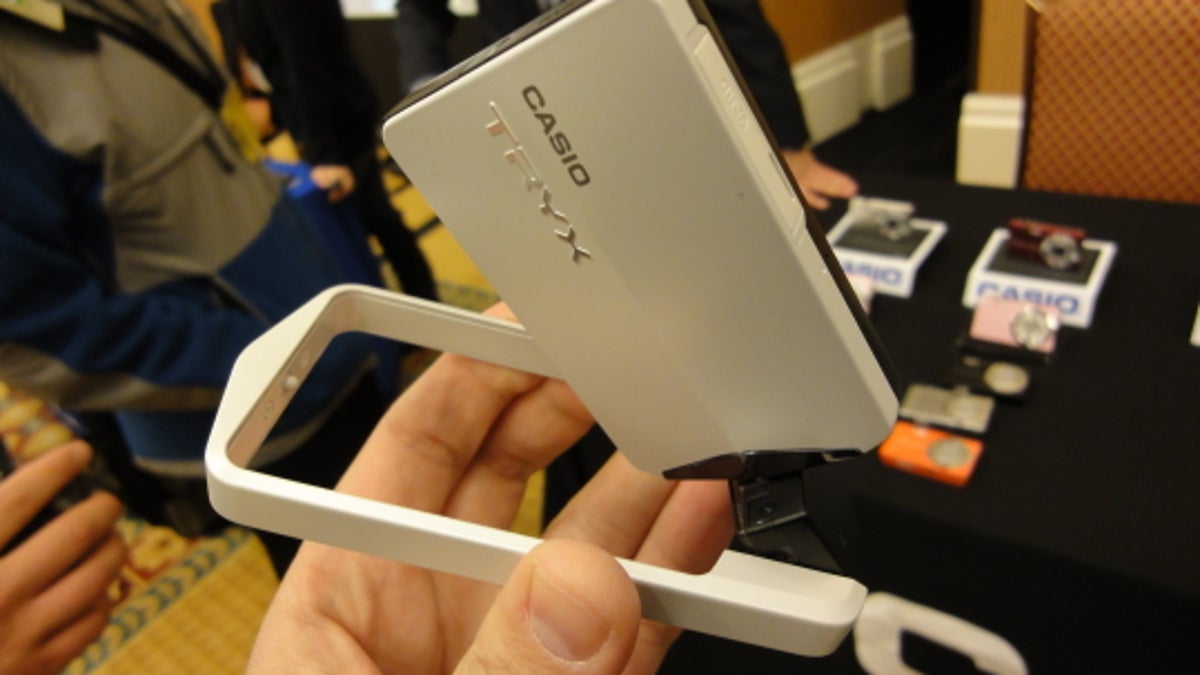CES: Digital camera wrap-up
A unique design and cool wireless technologies highlight some otherwise humdrum camera announcements at CES 2011.

When it comes to digital camera announcements, CES generally isn't a big show. There is usually a handful of headline grabbers, but for the most part it's just announcements of budget and style lines.
Probably the biggest splash was made by Casio with its Tryx camera. Its shooting features aren't necessarily extraordinary (it does do some cool stuff, though), but its design makes it special. Most of the camera is a 3-inch touch-screen LCD that pops out of a frame and rotates around with its f2.8 21mm-equivalent ultrawide-angle lens 360 degrees. The screen itself swivels 270 degrees.
Why would you want this? Basically, it allows you to position the camera in a number of ways, effectively making the camera its own tripod. That means without much effort you can stand or hang the Tryx and get in front of the camera and still see what you're shooting. Plus, a built-in orientation sensor rights the image, so you can shoot with your left or right hand.
For those that like to shoot and share, there were a couple of noteworthy announcements. The $199.99 Samsung SH100 has built-in 802.11n Wi-Fi that can be used for several different things. Of course you can connect to hot spots with it for instant uploads to sharing sites. You can also set it to back up your photos and movies wirelessly with a touch of a button. But perhaps the coolest feature is the ability to tether it to an Android-powered smartphone (only Samsung's Galaxy S phones will be supported at launch, though) and then use it to control the camera remotely. The smartphone screen will be your viewfinder and you can tap to shoot as well as control the 5x zoom lens.
If you already have a camera or have realized your smartphone isn't a great camera for all occasions, wireless SD card maker Eye-Fi announced a feature update to its X2 cards called Direct Mode. This enables the card to create its own hot spot, so that devices running the company's app on a mobile operating system like Android will be able to pull photos off the camera and into the phone. You'd then be able to use your mobile device to send shots to sharing sites or display them on a larger screen like a tablet. This gives you the power and quality you'd get with good camera, but the wireless flexibility of an always-connected device.
Though most of the camera manufacturers announced a handful of models each (save for Nikon and Pentax, who had none), Fujifilm got a little silly and announced 16 cameras at once, which is nearly a full refresh of its entire offerings. The one many consumers will find the most exciting is the FinePix HS20EXR. It's the company's top full-size megazoom featuring a 30x manual zoom lens and a new sensor that combines Fujifilm's EXR technology and a backside-illuminated CMOS sensor. It should result in better low-light photos, faster performance, and increased dynamic range. If you want one that fits in your pocket, the 15x F500EXR and F550EXR (the latter has built-in GPS for geotagging) uses the same sensor and has essentially the same shooting options.
Enthusiasts will likely be more interested in the Fujifilm X100, though. It wasn't announced at CES, but it was on display. It features an APS-C-size 12-megapixel CMOS, f2.0 23mm lens with a nine-bladed aperture, and a specially designed hybrid optical/electronic viewfinder. If you've been eying something like the Leica X1, the X100 might turn out to be a better choice at half the price.
It was nice to see this wasn't the only enthusiast compact making the rounds at CES, too. Olympus officially announced the XZ-1, a competitor to Canon's PowerShot S95 and Panasonic's Lumix LX5 as well as a new Micro Four Thirds camera, the E-PL2. And among the 11 cameras that Sony announced at CES was the Cyber-shot DSC-WX10. It's more "average consumer" than the XZ-1, but its bright f2.4 24mm-equivalent ultrawide-angle lens and manual controls certainly make it more desirable to enthusiasts than a typical point-and-shoot.
While the growing number of enthusiast compacts is encouraging, the jump to 16-megapixel sensors in point-and-shoots is not. Sony, Panasonic, Casio, Samsung, Fujifilm, and Canon announced models with 16-megapixel resolution. In the case of Panasonic, it used the higher megapixel count as an upsell between similar models. The sensors are not any larger, either, so the photo quality just isn't going to improve. I can keep repeating over and over how more megapixels on a point-and-shoot at this stage is a very bad thing, but as long as consumers keep thinking a higher number is better, the manufacturers aren't going to stop. That means that come CES 2012 we'll likely see 18-megapixel compact cameras.
What's funny is that while enthusiasts are quick to point out that fewer megapixels is better, they're not saying much about extreme megazoom lenses that are a detriment to image quality, too. Along with the models from Fujifilm I mentioned (and a few others that I didn't), Sony, Samsung, Olympus, Casio, and Kodak all announced new full-size and/or compact megazooms. Combine these lenses with 16-megapixel sensors and the photos will likely look pretty poor.
I expected more 3D cameras to show up, but there were only a handful from Sony and Olympus, and they digitally fake it. (It was the camcorder manufacturers that really jumped on 3D at CES 2011.) It's especially weird that Panasonic and Samsung didn't have anything, so I'm guessing that 3D-enabled cameras from them will come later this year.
Again, this CES wasn't really any different than shows of the past few years. There were a couple camera announcements that are trying to push the category forward, but the majority of them are just refreshes with more megapixels, bigger screens, and longer lenses--all at lower prices.

